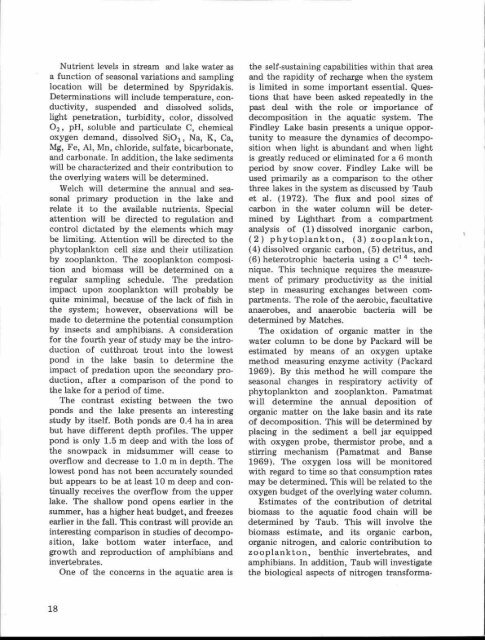PE EIE[R-Rg RESEARCH ON - HJ Andrews Experimental Forest
PE EIE[R-Rg RESEARCH ON - HJ Andrews Experimental Forest
PE EIE[R-Rg RESEARCH ON - HJ Andrews Experimental Forest
Create successful ePaper yourself
Turn your PDF publications into a flip-book with our unique Google optimized e-Paper software.
Nutrient levels in stream and lake water a s<br />
a function of seasonal variations and samplin g<br />
location will be determined by Spyridakis .<br />
Determinations will include temperature, conductivity,<br />
suspended and dissolved solids ,<br />
light penetration, turbidity, color, dissolve d<br />
O 2 , pH, soluble and particulate C, chemical<br />
oxygen demand, dissolved SiO 2 , Na, K, Ca ,<br />
Mg, Fe, Al, Mn, chloride, sulfate, bicarbonate ,<br />
and carbonate . In addition, the lake sediment s<br />
will be characterized and their contribution t o<br />
the overlying waters will be determined .<br />
Welch will determine the annual and seasonal<br />
primary production in the lake an d<br />
relate it to the available nutrients . Special<br />
attention will be directed to regulation an d<br />
control dictated by the elements which may<br />
be limiting. Attention will be directed to th e<br />
phytoplankton cell size and their utilizatio n<br />
by zooplankton . The zooplankton composition<br />
and biomass will be determined on a<br />
regular sampling schedule. The predatio n<br />
impact upon zooplankton will probably b e<br />
quite minimal, because of the lack of fish i n<br />
the system ; however, observations will b e<br />
made to determine the potential consumptio n<br />
by insects and amphibians . A consideration<br />
for the fourth year of study may be the introduction<br />
of cutthroat trout into the lowes t<br />
pond in the lake basin to determine th e<br />
impact of predation upon the secondary production,<br />
after a comparison of the pond t o<br />
the lake for a period of time .<br />
The contrast existing between the tw o<br />
ponds and the lake presents an interestin g<br />
study by itself. Both ponds are 0.4 ha in area<br />
but have different depth profiles . The upper<br />
pond is only 1 .5 m deep and with the loss of<br />
the snowpack in midsummer will cease to<br />
overflow and decrease to 1 .0 m in depth . The<br />
lowest pond has not been accurately sounde d<br />
but appears to be at least 10 m deep and continually<br />
receives the overflow from the upper<br />
lake. The shallow pond opens earlier in th e<br />
summer, has a higher heat budget, and freezes<br />
earlier in the fall. This contrast will provide an<br />
interesting comparison in studies of decomposition,<br />
lake bottom water interface, an d<br />
growth and reproduction of amphibians an d<br />
invertebrates .<br />
One of the concerns in the aquatic area is<br />
the self-sustaining capabilities within that are a<br />
and the rapidity of recharge when the syste m<br />
is limited in some important essential . Questions<br />
that have been asked repeatedly in th e<br />
past deal with the role or importance of<br />
decomposition in the aquatic system. The<br />
Findley Lake basin presents a unique opportunity<br />
to measure the dynamics of decomposition<br />
when light is abundant and when ligh t<br />
is greatly reduced or eliminated for a 6 month<br />
period by snow cover. Findley Lake will be<br />
used primarily as a comparison to the othe r<br />
three lakes in the system as discussed by Tau b<br />
et al. (1972) . The flux and pool sizes of<br />
carbon in the water column will be deter -<br />
mined by Lighthart from a compartment<br />
analysis of (1) dissolved inorganic carbon ,<br />
(2) phytoplankton, (3) zooplankton ,<br />
(4) dissolved organic carbon, (5) detritus, and<br />
(6) heterotrophic bacteria using a C 14 technique.<br />
This technique requires the measurement<br />
of primary productivity as the initial<br />
step in measuring exchanges between compartments.<br />
The role of the aerobic, facultative<br />
anaerobes, and anaerobic bacteria will be<br />
determined by Matches .<br />
The oxidation of organic matter in th e<br />
water column to be done by Packard will be<br />
estimated by means of an oxygen uptak e<br />
method measuring enzyme activity (Packard<br />
1969). By this method he will compare th e<br />
seasonal changes in respiratory activity o f<br />
phytoplankton and zooplankton . Pamatmat<br />
will determine the annual deposition of<br />
organic matter on the lake basin and its rat e<br />
of decomposition . This will be determined by<br />
placing in the sediment a bell jar equippe d<br />
with oxygen probe, thermistor probe, and a<br />
stirring mechanism (Pamatmat and Bans e<br />
1969). The oxygen loss will be monitore d<br />
with regard to time so that consumption rate s<br />
may be determined. This will be related to th e<br />
oxygen budget of the overlying water column .<br />
Estimates of the contribution of detrital<br />
biomass to the aquatic food chain will b e<br />
determined by Taub . This will involve th e<br />
biomass estimate, and its organic carbon ,<br />
organic nitrogen, and caloric contribution t o<br />
zooplankton, benthic invertebrates, an d<br />
amphibians . In addition, Taub will investigat e<br />
the biological aspects of nitrogen transforma -<br />
18








